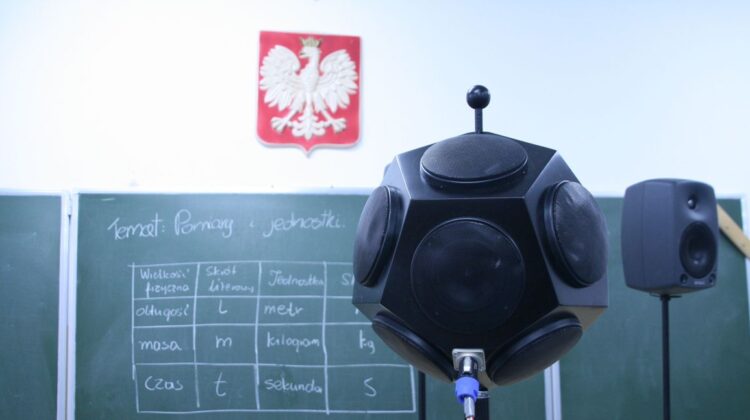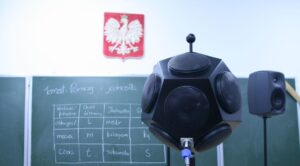
A year ago we wrote here on Acoustic Bulletin.com, about the newly published Polish Standard PN-B-02151-4:2015-06 setting the demands concerning room acoustics in public use buildings, mostly in office, educational and healthcare premises.
Since it was the first Polish standard dealing with room acoustics, we wanted to do as much as possible to make this document known and understood. During last 12 months we have co organised a series of trainings for Chamber of Architects, a series that gathered about 750 participants (out of 10.000 members). We spoke about standard at many third party organized seminars and conferences and lectures for students of architecture, interior design and acoustics. We prepared a brochure and an on-line guide with an equivalent sound absorption area calculator (available here). We have also been authors or co-authors of many articles published in trade press addressed to the architects, civil engineers, local authorities, school staff or even pupils’ parents. Right now during June and July, we have articles in three magazines addressed to civil engineers, acousticians and architects with total volume over 130.000 copies, so we are optimistic that the message is getting out there. We have also been interviewed live and broadcast by a nationwide radio station in Poland.
This effort has contributed to better general awareness of room acoustics encouraged discussions which in turn resulted in a deeper level of engagement when a month ago the ministry of infrastructure and construction presented a project of revised decree on technical conditions to be met by buildings. This is a mandatory regulation to be obeyed during design and construction of new buildings and major refurbishments that is revised on a regular basis. It contains an appendix with the list of cited Polish Standards (that makes these standards effectively mandatory). Despite earlier recommendation given by ITB (state Building Research Institute) the standard PN-B-02151-4:2015-06 did not appear in the appendix to be a mandatory requirement. During a public questionnaire many institutions reported the need to attach this standard to a revised decree, mostly because it quantifies general demands present in this regulation. Among the supporters we can find not only the expected building professionals SARP (Polish Architects Association), ITB, acousticians representing universities but also pupils’ parents association or even parents’ council of one primary school fighting for funds to prevent noisy school corridors. A public questionnaire is still open and available at the homepage of the Governmental Centre of Legislation. For further details ask the author see below.
Government decree on technical conditions to be met by buildings says about need:
– to control the noise generated in the rooms (by limiting sound bounces)
– to provide good environment for speech communications.
Standard PN-B-02151-4:2015-06 complete decree postulate by setting specific demands for indicated types of rooms.
The first part of the standard sets demands for rooms designed for speech communication (e.g. classrooms, lecture theatres, conference rooms). In this case, two criteria (to be fulfilled altogether) are established: maximum RT (Reverberation Time) and minimum STI (Speech Transmission Index). Their values vary depending on room type and volume. There are also special requirements for rooms for early education, language teaching or destined for people with a hearing impairment.
Some examples below:

There are also special requirements for rooms for early education and language teaching (values from table above reduced by 0,1 s) or destined for people with a hearing impairment (RT≤ 0,6). Reverberation time should be below specified threshold in all octave bands 250 Hz – 8 kHz. In 125 Hz a 30% overrun is acceptable.
The second part of demands concerns rooms where noise levels is a main priority (variety of rooms from swimming pools, through school corridors to call centres). Demands here are split between maximum RT and minimum equivalent absorption area related to room floor area. RT should be below the specified threshold in all octave bands 250 Hz – 4 kHz. The demanded equivalent absorption area should be reached in 500 Hz – 2 kHz. The Standard also contains guidelines for RT and STI measurements and informative appendices explaining method of rooms’ absorption calculations.
It was published in Polish and is available at PKN on-line store here:
For more info contact Mikolaj Jarosz Concept Developer for Educational Environments with Ecophon in Poland.


